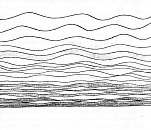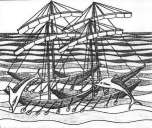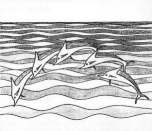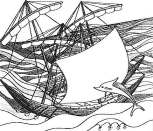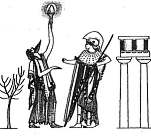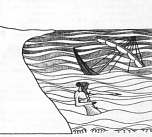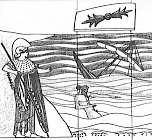.
Heron von Alexandria, Biographie, Erfindungen, Wissenschaft
Part 2
Fire extinction Machine
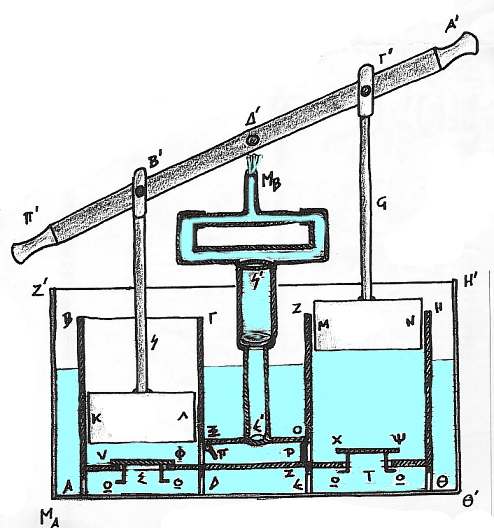
Two Piston Machine for continuous flow of water for fire extinction, probably a work of Ctesibius (c. 250 BC) that Hero improved. http://www.history.rochester.edu/steam/hero/section27.html , image from the Greek Newspaper Eleftherotypia
Thunder-Making Machine
Used in a theater to announce the entrances and exits of the gods. Pulling the lever opens a trap door which allows numerous brass balls to cascade down a series of shelves and onto a tin sheet. Heron's thunder-making machine resonated with deep bass tones when the balls were released.
The amphora of Heron of Alexandria How to turn water into wine (and vice versa)
Heron's Lamps
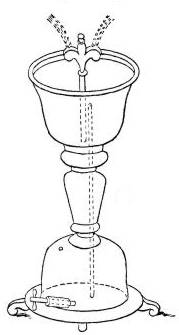
In Hero's "Spiritalia," is a description of a lamp in which a supply of oil from a reservoir below is driven up by means of air introduced into the base by an air-pump. In another form of Hero's lamp, the oil is raised by water, introduced below the oil by means of a pipe. Knight's Mechanical Encyclopedia
See: http://www.history.rochester.edu/steam/hero/section72.html , http://www.history.rochester.edu/steam/hero/section71.html
Hydraulis or water-organ
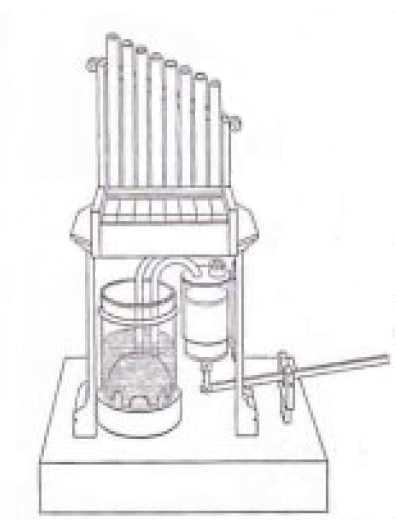
Heron describes also the hydraulis actually invented by Ctesibius of Alexandria in the 3rd Century B.C. The hydraulis was the first keyboard musical instrument and the ancestor of the modern church organ.
See: Ctesibius and the hydraulis
Heron's magic fountain
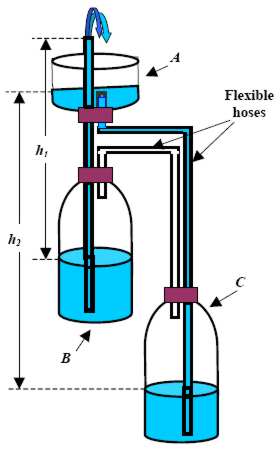
A remarkable mechanism, see Figure above, to produce a fountain in a open cup A using two closed containers B and C while water flows from B to C.
See a description by Roman Ya. Kezerashvili and Alexander Sapozhnikov: PDF File
Heron's COIN automat
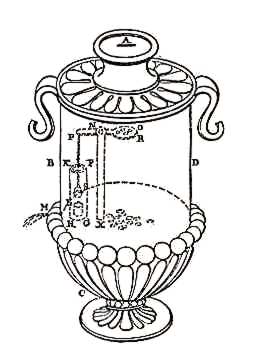
A coin is inserted in A and lands on the receiver R causing it to fall. This action would raise the other side of the lever P to rise opening the valve and allowing water to flow out of the spout M. The coin would slide off of the receiver and the valve would close.
From: A History of Science by Henry Smith Williams:
..There is one mechanism described by Hero which was a most explicit anticipation of a device, which presumably soon went out of use, and which was not reinvented until towards the close of the nineteenth century. This was a device which has become familiar in recent times as the penny-in-the-slot machine. When towards the close of the nineteenth century some inventive craftsman hit upon the idea of an automatic machine to supply candy, a box of cigarettes, or a whiff of perfumery, he may or may not have borrowed his idea from the slot-machine of Hero; but in any event, instead of being an innovator he was really two thousand years behind the times, for the slot-machine of Hero is the precise prototype of these modern ones.
The particular function which the mechanism of Hero was destined to fulfil was the distribution of a jet of water, presumably used for sacramental purposes, which was given out automatically when a five- drachma coin was dropped into the slot at the top of the machine. The internal mechanism of the machine was simple enough, consisting merely of a lever operating a valve which was opened by the weight of the coin dropping on the little shelf at the end of the lever, and which closed again when the coin slid off the shelf.
...Yet to the worshippers, who probably had entered the temple through doors miraculously opened, and who now witnessed this seemingly intelligent response of a machine, the result must have seemed mystifying enough; and, indeed, for us also, when we consider how relatively crude was the mechanical knowledge of the time, this must seem nothing less than marvellous. As in imagination we walk up to the sacred tank, drop our drachma in the slot, and hold our hand for the spurt of holy-water, can we realize that this is the land of the Pharaohs, not England or America; that the kingdom of the Ptolemies is still at its height; that the republic of Rome is mistress of the world; that all Europe north of the Alps is inhabited solely by barbarians; that Cleopatra and Julius Caesar are yet unborn; that the Christian era has not yet begun? Truly, it seems as if there could be no new thing under the sun.
A Reconstruction
Sequence Control
Heron of Alexandria described a mechanism or apparatus that made use of the so called "sequence control" mechanism. This mechanism used drums in which pins and gears were mounted to control events that 'laid ahead'. Sequence control gives means to foretell the outcome of a sequence of events in advance, without influencing the outcome directly. Examples of sequence control are a music box with a drum on which pins are attached that strike against the teeth of a comb. Teeth that have predefined lengths and thus possess their own tone. By striking teeth in a predefined sequence a melody will sound. Sequence control is defined as a lower generation of computer programs.The operator feeds machines like that with certain limited input and lets the machine run on its own without external control for the outcome: actions to move mechanical contraptions, music or calculations.
Heron Screw Press
Use of Wind Power
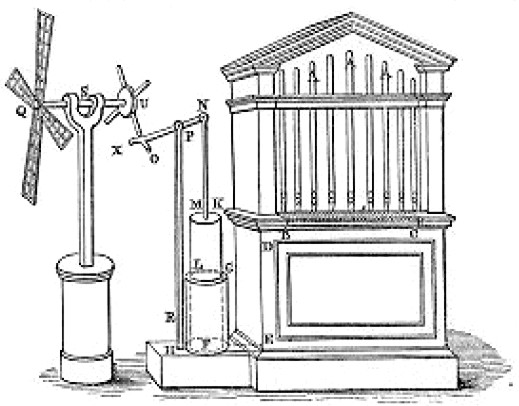
From a PhD Thesis about the history of the Organ (Author unknown but will provide if found):
The power supply for the wind-driven organ relies on the transfer of motion from the “broad arms like the sails of a wind-mill” to the piston mechanism. The arms are attached to one end of a rod, which is supported such that it turns freely. As the arms turn in the wind, the rod conveys a rotary motion to a gear-like pegged disk fitted tightly on the opposite end. The revolving pegs make contact with a lever attached by a pin to the piston rod, causing the piston to be raised as each peg engages the rod mechanism. When the peg advances beyond the lever, the lever is released and the piston descends in the cylinder. The falling piston compresses the air, forcing it out into the base of the cylinder, up through a connecting tube, and into the box on which the pipes stand. As the key mechanism is activated, air is released into the pipes, causing “the sound of a flute” to be produced. To assure a steady supply of air, the windmill frame can be turned directly into the prevailing wind. the wind-powered organ is the only known documented windmill type mechanism in antiquity. Wind power does not reappear in Western civilization until the twelfth century. ....from an historical point of view, these instruments incorporate a manual keyboard, which as an artifact seems to be without precedent. Finally, the gear-like mechanism of the pegged disk attached to the windmill shaft is designed to transfer power from the rotating shaft to the reciprocating piston, thus converting circular to reciprocal motion.
See: http://www.history.rochester.edu/steam/hero/section76.html
Heron's Automatic Theater
A moving automaton like a small theater opens the doors and different scenes are shown with moving figures. Probably a continuation of a work that already Philon of Byzantium started around 280 BC writing a chapter "On Automatic Theaters" . An example of Heron's automatic theaters is given by Kalligeropoulos in his book about Heron (Greece, 1996) from where the images are taken:
|
Heron's Automatic Theater |
||
|---|---|---|
|
12 Danaer are building their ships. The figures move automatically, cutting the wood for the ships |
The doors of the Theater close, they open again and a new scene appears; The Danaer move their ships into the sea. |
The doors close and open with an empty sea shown |
|
Next scene, ships with dolphins jumping from time to time |
Next scene, only dolphins jumping from time to time |
Next scene, a sea-storm, the ships move up and down |
|
Next scene, Nauplios and Athena appear. Nauplios cares a burning torch |
Next scene, Ajax is seen with the sunken ships |
Next scene, A loud thunder, Aias sinks in the water hit by a thunderbolt, Athena appears |
Image from the Greek Newspaper Eleftherotypia
Heron's work The Automaton Theater describes theatrical constructions that move by means of weights on strings wrapped around rotating drums.With this power source, Heron constructed an automatic theater that presented Nauplius, a tragic tale set in the period after the Trojan War. As (presumably) amazed playgoers watched, the doors to a miniature theater swung open, and animated figures acted out a series of dramatic events, including the repair of Ajax's ship by nymphs wielding hammers, the Greek fleet sailing the seas accompanied by leaping dolphins, and the final destruction of Ajax by a lightning bolt hurled at him by the goddess Athena. Perhaps inspired by Hephaestus's obedient moving tables, Heron also made wheeled stands and used an ingenious trick to move them, apparently self-animated, around the theater. A weight rested on a hopper-full of grain, which leaked out through a small hole in the bottom. As the weight gradually sank, it pulled a rope wound around an axle of the stand to turn its wheels and make it move. Along with the power of falling weights, these figures used the basic mechanical resources of wheels, pulleys, and levers to create a variety of motion, but there were drawbacks. While a weight resting on slowly leaking grain delivers power over a relatively long period, it is not very compact, or usable on demand. And beyond repetitive actions like hammering, a system based on simple machines gives little scope for flexible and responsive motion. But better techniques to provide and control power came along, although only long after Greek times.The new power source was the coiled metal spring, and the new means of control was clockwork. We do not know who first noted that a flexible piece of metal could store energy, but we use the method daily; for example, in the common safety pin. Early Greek artisans such as Philon and Heron understood that a "springy" material could act as a power source. Philon even designed a crossbow that used bronze springs to fling missiles. But these early springs were too weak to be useful, and it was not until the fifteenth century that good-quality coiled springs came into use. In their time, springs played the role that electrical batteries now do in powering devices. They animated the next wave of artificial beings, once ways were found to control their stored power through their use in clocks. ( from Digital People: From Bionic Humans to Androids (2004)
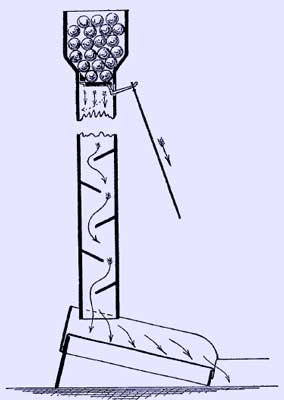
Sound for Theater. Device for "Sound of Thunder" production
Heron Talking Machines???
Incidents of the Breath: In Pneumatic and Electric Ventriloquisms, Steve Connor
A lecture given in the series 'Artificial Others: Lectures on Ventriloquism and Automata' at the Ruskin School of Art and Drawing, Oxford, February 17, 2004 http://www.bbk.ac.uk/eh/skc/incidents/
Heron's ideas were reported in one of the most influential books of natural magic, Giambattista della Porta's Natural Magick of 1584. Book 19 of Natural Magick is devoted to the topic of 'Whether material Statues may speak by any artificial way'. The book begins with the report that, in ancient times, 'there was a colossus of Brass, placed on a mighty high pillar, which in violent tempests of wind from the nether parts, received a great blast, that was carried from the mouth to a trumpet, that it blew strongly, or else sounded some other instrument, which I believe to have been easy, because I have seen the like'. Della Porta goes on to discourse upon the properties of sound upon which both musical instruments and speaking statues depend: 'We see that the voice of a sound, will be conveighed entire through the air, and that not in an instant, but by degrees in time. The fact that sounds are preserved and conveyed 'entire without interruption, unless they break upon some place' makes it possible to convey sounds great distances: 'If any man shall make leaden pipes exceeding long, two or three hundred paces long (as I have tried) and shall speak in them some or many words, they will be carried true through those pipes and be heard at the other end, as they came from the speaker's mouth.' This principle of the preservation of sound convinced della Porta, as it did others, that cunningly engineered pipeworks might be able also to trap sound, not just conveying it through space, but holding it up in time, thereby adding a phonographic to a telephonic principle:
Wherefore if that voice goes with time, and hold entire, if an man as the words are spoken shall stop the end of the pipe, and that is at the other end shall do the like, the voice may be intercepted in the middle, and be shut up as in a prison. And when the mouth is opened, the voice will come forth, as out of his mouth that spoke it. But because such long pipes cannot be made without trouble, they may be bent up and down like a trumpet, that a long pipe may be kept in a small place. And when the mouth is open, the words may be understood. I am now upon trial of it.
Another Source:
The following history was written by Semi J. Begun who pioneered magnetic tape recording at the Brush Development Company in Cleveland, Ohio. Begun immigrated from Germany in 1938 where he had developed a steel-tape recorder for the C. Lorenz Company. In 1939, he led the research program at Brush Development that produced recording equipment for the U. S. military in World War II. This is the first chapter of the book he wrote in 1949 on magnetic recording:
Myth and folklore abound with tales of how the human voice has been captured or preserved, but the only known early attempts to realize this idea were the efforts to construct mechanical devices which would "talk." As early as the third century B.C., Heron of Alexandria is said to have devised automata which would talk or emit the cries of animals. The earliest such device of which we have any actual knowledge is the one constructed by De Kempelein of Vienna, who, in 1791, published a description of it under the title "The Mechanism of Speech, Followed by a Description of a Talking Machine." De Kempelein's device could be made to speak short sentences.
http://history.acusd.edu/gen/recording/begun1.html
Heron and Physics
from A History of Science Volume I by Henry Smith Williams :
The main purpose of Hero in his preliminary thesis has to do with the nature of matter, and recalls, therefore, the studies of Anaxagoras and Democritus. Hero, however, approaches his subject from a purely material or practical stand-point. He is an explicit champion of what we nowadays call the molecular theory of matter. "Every body," he tells us, "is composed of minute particles, between which are empty spaces less than these particles of the body. It is, therefore, erroneous to say that there is no vacuum except by the application of force, and that every space is full either of air or water or some other substance. But in proportion as any one of these particles recedes, some other follows it and fills the vacant space; therefore there is no continuous vacuum, except by the application of some force [like suction]--that is to say, an absolute vacuum is never found, except as it is produced artificially." Hero brings forward some thoroughly convincing proofs of the thesis he is maintaining. "If there were no void places between the particles of water," he says, "the rays of light could not penetrate the water; moreover, another liquid, such as wine, could not spread itself through the water, as it is observed to do, were the particles of water absolutely continuous." The latter illustration is one the validity of which appeals as forcibly to the physicists of to-day as it did to Hero. The same is true of the argument drawn from the compressibility of gases. Hero has evidently made a careful study of this subject. He knows that an inverted tube full of air may be immersed in water without becoming wet on the inside, proving that air is a physical substance; but he knows also that this same air may be caused to expand to a much greater bulk by the application of heat, or may, on the other hand, be condensed by pressure, in which case, as he is well aware, the air exerts force in the attempt to regain its normal bulk. But, he argues, surely we are not to believe that the particles of air expand to fill all the space when the bulk of air as a whole expands under the influence of heat; nor can we conceive that the particles of normal air are in actual contact, else we should not be able to compress the air. Hence his conclusion, which, as we have seen, he makes general in its application to all matter, that there are spaces, or, as he calls them, vacua, between the particles that go to make up all substances, whether liquid, solid, or gaseous.
In his Catoptrica, Heron showed by a geometrical method that the actual path taken by a ray of light reflected from a plane mirror is shorter than any other reflected path that might be drawn between the source and point of observation.
Hero of Alexandria is recognized (U.S. Committee on Opportunities in the Hydrological Sciences) as the first who formulated the discharge concept and made flow measurements.
Aristotle's observation that most motion appears to be in either straight lines or circles suggested to him a common generating principle, namely minimization: The straight line is the shortest route between two points, while the circle is the shortest periphery for a given area. The principle was then applied by Heron of Alexandria to prove that in a mirror, the angle of reflection is equal to the angle of incidence. Fifteen centuries later, Fermat (1601- 1665) used the same principle of the fastest route or minimal travel-time (and not minimal path as Heron assumed which is not always true) for the transition of light between two media, i.e. for the derivation of Snell's law.
Heron opinion was that light travels with infinite speed, explaining so the apparent straight line motion of light. This wrong idea persisted until 1676 when Olaf (Ole) Römer, a Danish astronomer, estimated the velocity of light from observations of eclipses of the Jupiter satellites passing into the shadow of Jupiter.
References:
U.S. Committee on Opportunities in the Hydrological Sciences (1991) Opportunities in the Hydrologic Sciences. National Academy Press, Washington, DC.
Heron's Mathematical discoveries
References
Sleeswyk, André Wegener "Vitruvius' Odometer", Scientific American 245.4 (October, 1981), pp. 188-200
The Forgotten Revolution: How Science was Born in 300 BC and Why It Had to Be Reborn Russo Lucio, Levy Silvio (translator), Springer, 2004, IX, 487 p., ISBN: 3-540-20068-1
LINKS
http://www.tmth.edu.gr/en/aet/5/55.html. The Technology Museum of Thessaloniki has a good web page on Hero
The Pneumatics of Hero of Alexandria , Translated for and edited by Bennet Woodcroft A list of 78 inventions with drawings and explanation
http://www.feuerwehrgeschichte.de/ffw55.htm Information of Firefight history and Heron’s contribution (In German!)
http://www.tmth.edu.gr/en/expo/ancient_greek_technology.html Ancient Greek Technology exhibition
http://www.mathpages.com/home/kmath281/kmath281.htm Hero and Fermat on Receding Mirrors
http://www.heronaerospace.com/index.html Aerospace propulsion named using Heron’s name
http://www.smith.edu/hsc/museum/ancient_inventions/hsclist.htm
Technical works by Heron of Alexandria, Aristides Quintilianus and Johannes Pediasimos, with diagrams, later 16th century. Oxford University
Aeolipilai in MAD Magazine Advertisements
See also:
The Antikythera Computer
Ancient Greek Inventions
Timeline of Ancient Greek Science and Technology
Ctesibius of Alexandria
Clepsydra of Ctesibius
Greek Military Technology (Armor, Ships, Catapults, Polybola, Siege and Radiation Weapons, Links)
| Ancient Greece
Science, Technology , Medicine , Warfare, , Biographies , Life , Cities/Places/Maps , Arts , Literature , Philosophy ,Olympics, Mythology , History , Images Medieval Greece / Byzantine Empire Science, Technology, Arts, , Warfare , Literature, Biographies, Icons, History Modern Greece Cities, Islands, Regions, Fauna/Flora ,Biographies , History , Warfare, Science/Technology, Literature, Music , Arts , Film/Actors , Sport , Fashion --- |



